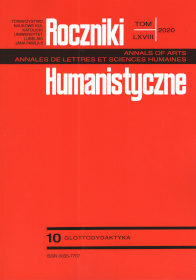Successful Classroom Management in English Language Instruction
Abstrakt
Umiejętne zarządzanie klasą w procesie nauczania języka angielskiego
Artykuł ma na celu podkreślić znaczenie dostosowania organizacji klasy i technik nauczania języka angielskiego do uczniów z różnych grup wiekowych szkoły podstawowej. Aby skutecznie wdrożyć to rozwiązanie, nauczyciel powinien być świadomy różnic rozwojowych dla każdego wieku oraz zdobyć umiejętność zarządzania klasą. Kluczowe znaczenie ma również fachowa wiedza teoretyczna związana z wczesnym nauczaniem języka angielskiego (np. hipoteza okresu krytycznego oraz teoria rozwoju poznawczego według Piageta) i zastosowanie jej w praktyce nauczycielskiej. Aplikując rozwiązania omówione w tym artykule, nauczyciel ma szansę odnieść sukces w nauczaniu języków.
Bibliografia
Baer, George G. “Preventative and classroom-based strategies.” Handbook of Classroom Management, edited by Edmund T. Emmer and Edward J. Sabornie. 2nd ed., Taylor and Francis Group, 2015, pp. 15-39.
Banerjee, Rashida, and Eva Horn. “Supporting Classroom Transitions Between Daily Routines: Strategies and Tips.” Young Exceptional Children, vol. 16, no. 2, 2013, pp. 3-14.
Birdsong, David. “Age and second language acquisition and processing: a selective overview.” Language Learning, vol. 56, 2006, pp. 9-49.
Brophy, Jere. “History of research on classroom management.” Handbook of Classroom Management: Research, Practice, and Contemporary Issues, edited by Carolyn M. Evertson and Carol S. Weinstein, Lawrence Erlbaum Associates, 2006, pp. 17-43.
Brown, Douglas H. Principles of Language Learning and Teaching. 5th ed., Pearson, 2007.
Bruner, Jerome. Child’s Talk: Learning to Use Language. Oxford UP, 1983.
Brzeziński, Jerzy. O nauczaniu języków obcych dzieci [About Teaching Foreign Languages to Children]. WSiP, 1987.
Cameron, Lynn. Teaching Languages to Young Learners. Cambridge UP, 2001.
Doff, Adrian. Teach English: A Training Course for Teachers. 14th ed., Cambridge UP, 2000.
Durlak, Joseph A., Roger P. Weissberg, Allison Dymnicki, Rebecca Taylor, and Kriston Schellinger. “The impact of enhancing students’ social and emotional learning: A meta-analysis of school-based universal interventions.” Child Development, vol. 82, 2011, pp. 405-432.
European Commission/EACEA/Eurydice. Key Data on Teaching Languages at School in Europe – 2017 Edition. Eurydice Report. Publications Office of the European Union, 2017.
Evertson, Carolyn M., and Carol S. Weinstein, editors. Handbook of Classroom Management: Research, Practice, and Contemporary Issues. Erlbaum, 2006.
Gilzow, Douglas F. Model Early Foreign Language Programs: Key Elements. Center for Applied Linguistics, 2002.
Halliwell, Susan. Teaching English in the Primary Classroom. Longman, 1992.
Henley, Martin. Classroom Management: A Proactive Approach. 2nd ed., Pearson, 2010.
Kern, Laurence, and Nathan H. Clemens. “Antecedent strategies to promote appropriate classroom behavior.” Psychology in the Schools, vol. 44, 2007, pp. 65-75.
Komorowska, Hanna. Metodyka nauczania języków obcych [The Methodology of Teaching Foreign Languages]. Fraszka Edukacyjna, 2005.
Larsen-Freeman, Diane. Techniques and Principles in Language Teaching. 3rd ed., Oxford UP, 2011.
Lemov, Doug. Teach Like a Champion: 49 Techniques That Put Students on the Path to College. Jossey-Bass, 2010.
Martin, Nancy K., Nancy J. Schafer, Sandee McClowry, Tim Mainhard, and Theo Wubbels. “Expanding the definition of classroom management: Recurring themes and new conceptualizations.” Journal of Classroom Interaction, vol. 51, no. 1, 2016, pp, 36-45.
Piaget, Jean. Science of Education and the Psychology of the Child. Translated by Derek Coltman. Orion Press, 1970.
Piaget, Jean. “The role of action in the development of thinking.” Knowledge and Development, edited by Willis F. Overton and Jeanette McCarthy, Gallagher, 1977, pp. 17-42.
Salmon, Angela K. “Engaging young children in thinking routines.” Childhood Education, vol. 86, no. 3, 2010, pp. 132-137.
Singleton, David. The Age Factor in Second Language Acquisition: A Critical Look at the Critical Period Hypothesis. Multilingual Matters Ltd, 1995.
Slattery, Mary, and Jane Willis. English for Primary Teachers: A Handbook of Activities & Classroom Language. Oxford UP, 2001.
Szpotowicz, Magdalena, and Małgorzata Szulc-Kurpaska. Teaching English to Young Learners. Wydawnictwo Naukowe PWN, 2012.
Vygotsky, Lev S. Thought and Language. MIT Press, 1962.
Vygotsky, Lev S. Mind in Society. Harvard UP, 1978.
Watson, Kamille J., and Cynthia F. DiCarlo. “Increasing Completion of Classroom Routines Through the Use of Picture Activity Schedules.” Early Childhood Education Journal, vol. 44, no. 2, 2016, pp. 89-96.
Copyright (c) 2020 Roczniki Humanistyczne

Utwór dostępny jest na licencji Creative Commons Uznanie autorstwa – Użycie niekomercyjne – Bez utworów zależnych 4.0 Międzynarodowe.





